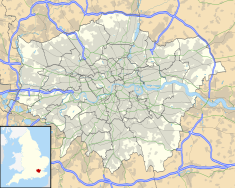Crossness Pumping Station
| Crossness Pumping Station | |
|---|---|

Western exterior of the Crossness Pumping Station
|
|
| Location | Crossness Sewage Treatment Works London, SE2 United Kingdom |
| Coordinates | 51°30′33″N 0°08′18″E / 51.509142°N 0.138418°E |
| OS grid reference | TQ4849781080 |
| Built | 1859–1865 |
| Architect | Charles Henry Driver and Joseph Bazalgette |
| Architectural style(s) | Romanesque |
| Owner | Thames Water |
|
Listed Building – Grade I
|
|
| Designated | 24 June 1970 |
| Reference no. | 1064241 |
The Crossness Pumping Station is a former sewage pumping station designed by the Metropolitan Board of Works's Chief Engineer Sir Joseph Bazalgette and architect Charles Henry Driver at the eastern end of the Southern Outfall Sewer in the London Borough of Bexley. Constructed between 1859 and 1865, as part of Bazalgette's redevelopment of the London sewerage system, it features spectacular ornamental cast ironwork, that Nikolaus Pevsner described as "a masterpiece of engineering – a Victorian cathedral of ironwork".
It is adjacent to Erith Marshes, a grazing marsh, the northern part of which is designated as Crossness Nature Reserve. This provides a valuable habitat for creatures ranging from moths to small amphibians and water voles.
The Southern Outfall Works, as the complex was originally called, was officially opened on 4 April 1865, by Edward, Prince of Wales, attended by Prince Alfred, the Duke of Cambridge, Prince Edward of Saxe-Weimar, the Archbishop of Canterbury, the Archbishop of York and the Lord Mayor of London, and many other persons of rank.
Following an address by Joseph Bazalgette, the Royal party toured the works and reservoirs, and the Prince then turned the wheel which started the engines and, as the Illustrated London News observed, "a sensible vibration was felt throughout the building, showing that the enormous beams, lifting-rods and flywheels were in operation."
...
Wikipedia

